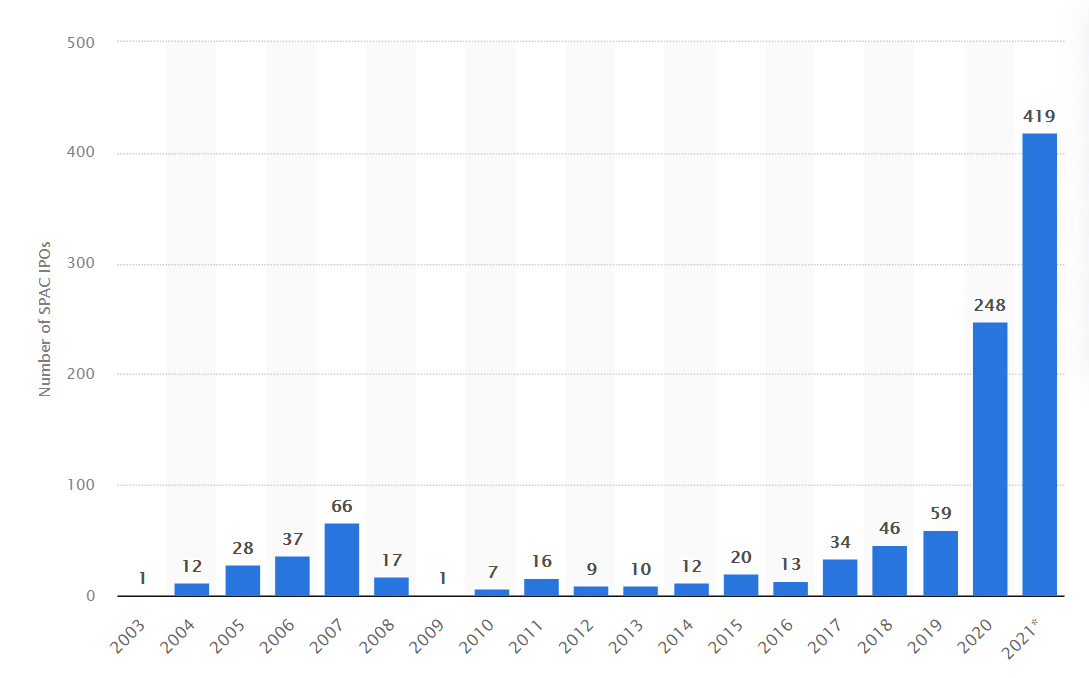This year, a word that has entered the vocabulary of many investors is SPAC, short for Special Purpose Acquisition Company. Yet, for some, what a SPAC exactly is and for what it is suitable, remains a mystery.
What exactly are SPACs?
I find it helpful to understand SPACs by breaking them down into bullet points:
- SPACs are shell companies with no business operations to speak of that are listed on stock exchanges.
- SPACs are usually sponsored by high-profile financial managers, such as former fortune500 CEOs and investment bankers.
- The purpose of a SPAC is to raise capital via its Initial Public Offering (IPO), which is then used to acquire (or merge with) an unlisted company.
- SPACs have two years from when they IPO to complete an acquisition or merger.
- A SPAC’s shareholders have to vote in favour of a proposed acquisition before it is finalised. After the merger of the two companies, the new entity is considered de-SPAC-ed
What are SPACs advantages?
The advantages SPAC’s provide are twofold. One advantage is for the SPAC sponsor, and the other is for the owners of the unlisted companies with which the SPAC mergers.
- Regarding the SPAC sponsor, their advantage is the significant stake they acquire in the SPAC (typically 20%) and the right to purchase more shares at a set price in the future (known as warrants).
- The appeal for unlisted companies to list on a stock exchange via a SPAC merger is its ease compared to a traditional IPO route. By merging with a SPAC, an unlisted company can forgo the lengthy and intrusive examinations and paperwork typically required to IPO.
Understanding how popular SPACs are in2021
Since emerging in the 1990s, SPACs have primarily remained a fringe financial product. That is, until last year when their popularity exploded in the US. In 2020, SPACs raised more than US $82 billion. Not to be outdone, 2021 eclipsed this value by April and has since gone on to raise more than US $120 billion. In contrast, SPACs raised a comparatively tiny US $13.6 billion in 2019.
According to Skadden, the rise in SPACs is due to recently enhanced investor protections and famous financial figures associating themselves with the investment vehicle. Names that have been associated with SPACs in the past couple of years include Bill Gates and Richard Branson, as either SPAC sponsors (Branson) or stakeholders in companies that have merged with a SPAC (Gates).
Risk Warning: Trading foreign exchange on margin carries a high level of risk and may not be suitable for all investors. The high degree of leverage can work against you as well as for you. Before deciding to trade foreign exchange, you should carefully consider your investment objectives, level of experience, and risk appetite. The possibility exists that you could sustain a loss of some or all of your initial investment and, therefore, you should not invest money you cannot afford to lose. You should make yourself aware of all the risks associated with foreign exchange trading and seek advice from an independent financial adviser if you have any questions or concerns as to how a loss would affect your lifestyle.
Recommended Content
Editors’ Picks
EUR/USD extends gains above 1.0700, focus on key US data

EUR/USD meets fresh demand and rises toward 1.0750 in the European session on Thursday. Renewed US Dollar weakness offsets the risk-off market environment, supporting the pair ahead of the key US GDP and PCE inflation data.
USD/JPY keeps pushing higher, eyes 156.00 ahead of US GDP data

USD/JPY keeps breaking into its highest chart territory since June of 1990 early Thursday, recapturing 155.50 for the first time in 34 years as the Japanese Yen remains vulnerable, despite looming intervention risks. The focus shifts to Thursday's US GDP report and the BoJ decision on Friday.
Gold closes below key $2,318 support, US GDP holds the key

Gold price is breathing a sigh of relief early Thursday after testing offers near $2,315 once again. Broad risk-aversion seems to be helping Gold find a floor, as traders refrain from placing any fresh directional bets on the bright metal ahead of the preliminary reading of the US first-quarter GDP due later on Thursday.
Injective price weakness persists despite over 5.9 million INJ tokens burned

Injective price is trading with a bearish bias, stuck in the lower section of the market range. The bearish outlook abounds despite the network's deflationary efforts to pump the price.
US Q1 GDP Preview: Economic growth set to remain firm in, albeit easing from Q4

The United States Gross Domestic Product (GDP) is seen expanding at an annualized rate of 2.5% in Q1. The current resilience of the US economy bolsters the case for a soft landing.
